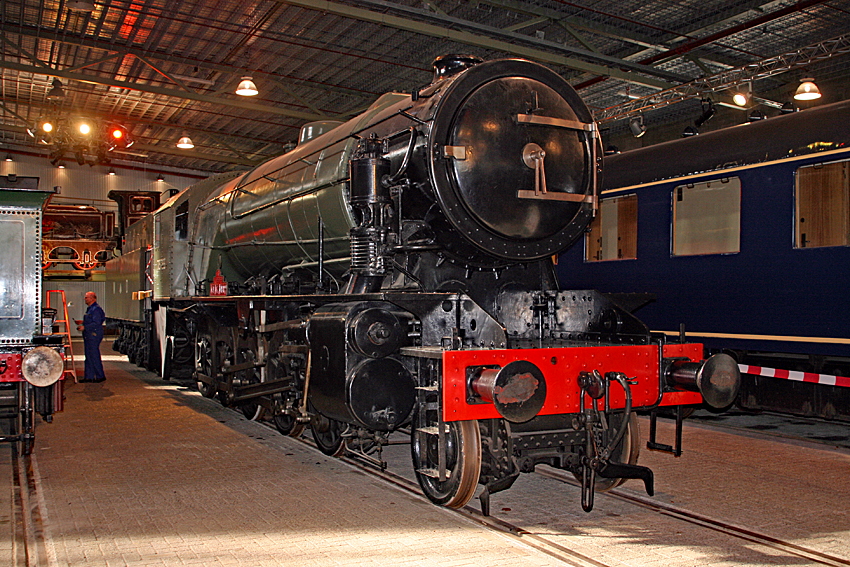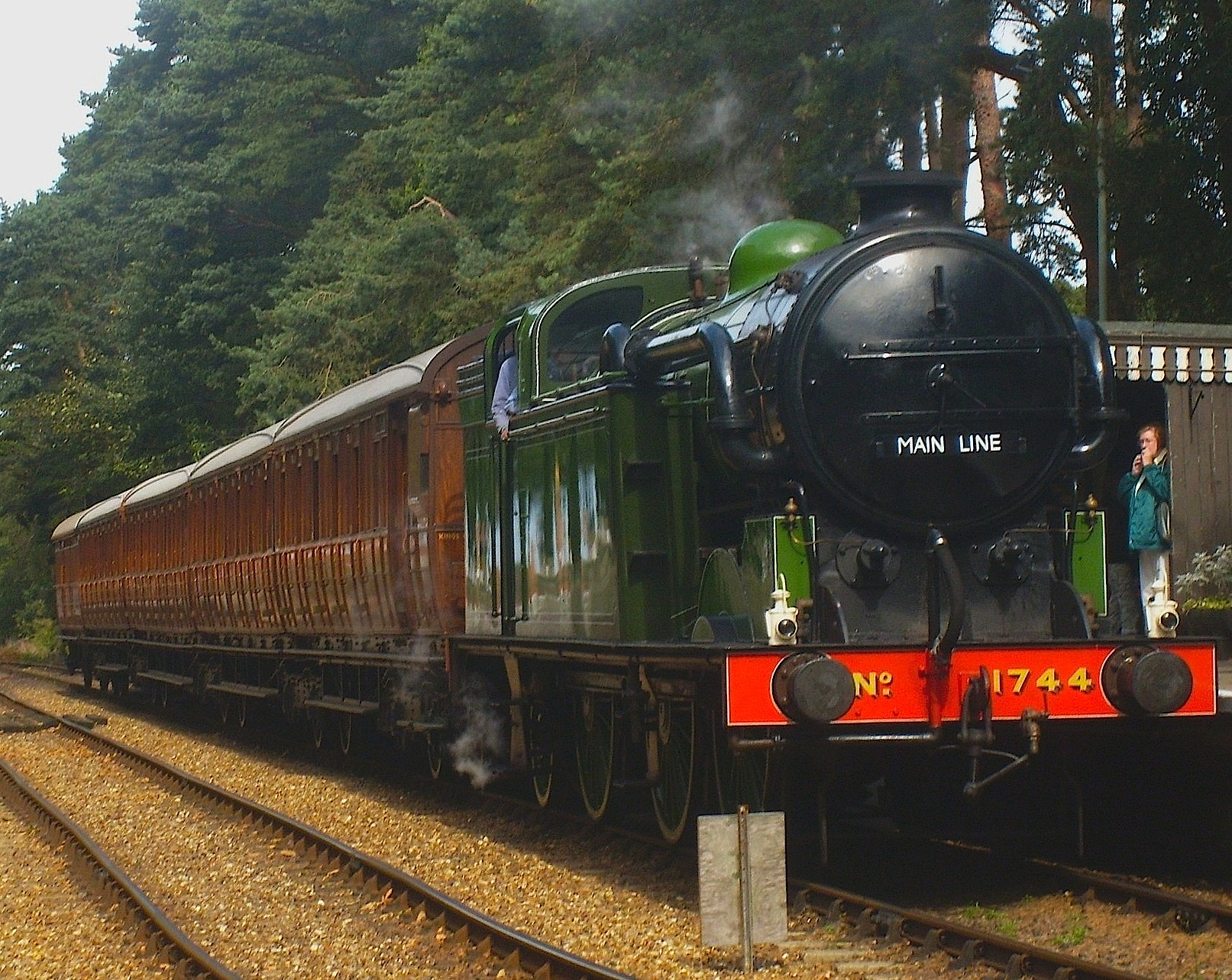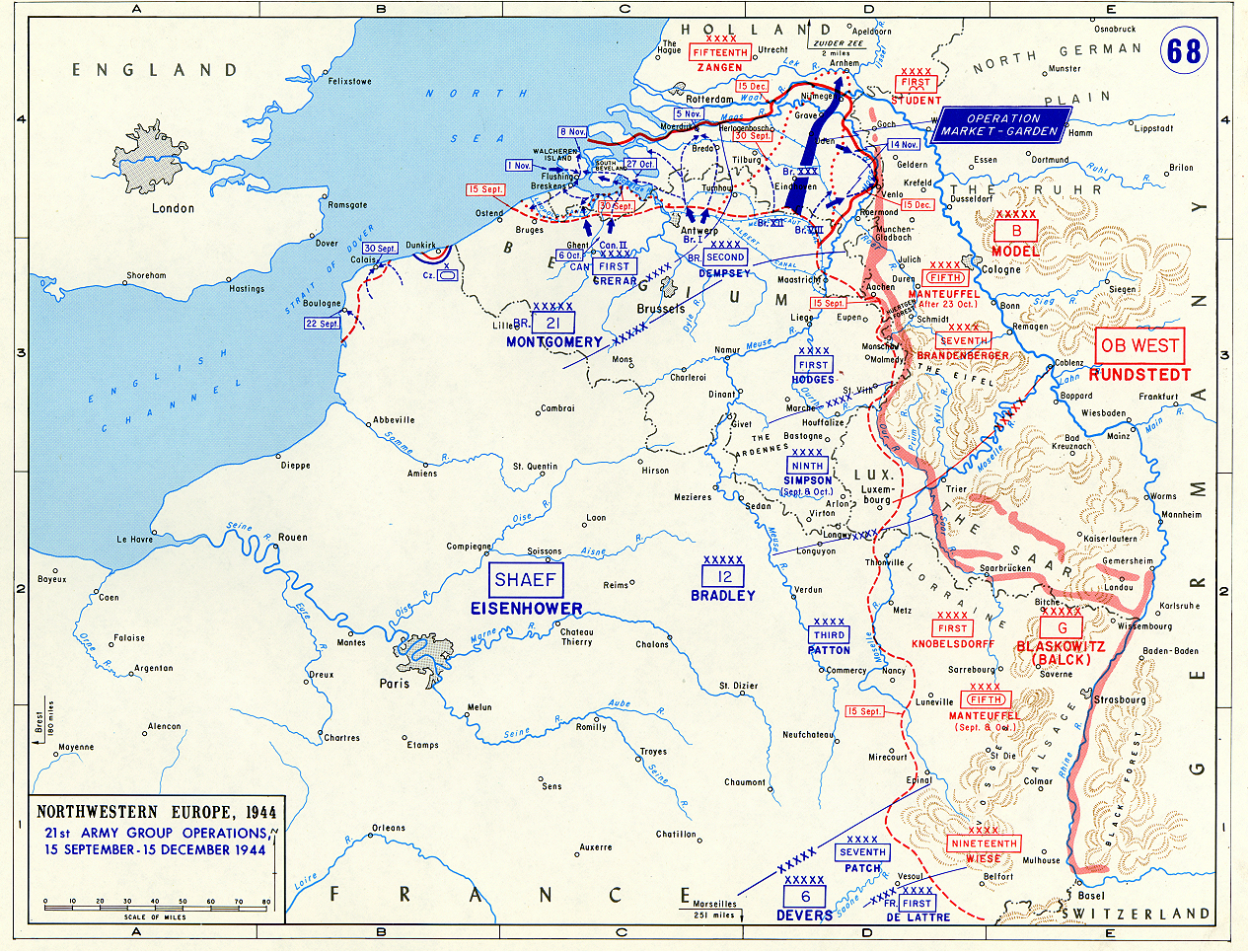|
WD Austerity 2-10-0
The War Department (WD) "Austerity" 2-10-0 is a type of heavy freight steam locomotive that was introduced during the Second World War in 1943. Background The Austerity 2-10-0 was based on the Austerity 2-8-0, and was designed to have interchangeable parts by R.A. Riddles. It had the same power output as the 2-8-0 but a lighter axle load, making it suitable for secondary lines. Design It had a parallel boiler and round-topped firebox. While the 2-8-0 had a narrow firebox, the 2-10-0 had a wide firebox placed above the driving wheels. This arrangement was common in the United States (e.g. the USRA 0-8-0) but unusual in Britain, where wide fireboxes were usually used only where there was a trailing bogie, e.g. in 4-4-2 and 4-6-2 types. These were the first 2-10-0 locomotives to work in Great Britain, and the first major class of ten-coupled engines — they had been preceded by two 0-10-0 locomotives; the Great Eastern Railway's Decapod and the Midland Railway's Licke ... [...More Info...] [...Related Items...] OR: [Wikipedia] [Google] [Baidu] |
North Norfolk Railway
The North Norfolk Railway (NNR) – also known as the "Poppy Line" – is a heritage steam railway in Norfolk, England, running between the towns of Sheringham and Holt. The North Norfolk Railway is owned and operated as a public limited company, originally called Central Norfolk Enterprises Limited. The railway is listed as exempt from the UK Railways (Interoperability) Regulations 2000. History Route history The line once formed part of the Midland and Great Northern Joint Railway's Melton Constable to Cromer Beach branch line. The first section, from Melton to Holt, was opened on 1 October 1884. After a suspension of work, the Holt to Cromer section of line was completed by direct labour, and opened on 16 June 1887. A through Kings Cross to Cromer express started running in August 1887, and although the construction had been expensive, the boost to revenue from the new line was considerable. A second train was put on the following year, in the down direction cons ... [...More Info...] [...Related Items...] OR: [Wikipedia] [Google] [Baidu] |
USRA 0-8-0
The USRA 0-8-0 was a USRA standard class of steam locomotive designed under the control of the United States Railroad Administration, the nationalized railroad system in the United States during World War I. This was the standard heavy switcher of the USRA types, and was of 0-8-0 wheel arrangement in the Whyte notation, or "D" in UIC classification The UIC classification of locomotive axle arrangements, sometimes known as the German classification''The Railway Data File''. Leicester: Silverdale, 2000. p. 52. . or German system,Kalla-Bishop P.M. & Greggio, Luciano, ''Steam Locomotives'', Cre .... A total of 175 locomotives were built under USRA control; these were sent to the following railroads: After the dissolution of the USRA, an additional 1200 copies of the USRA 0-8-0 were built for many railroads, However, there is a known survivor of this Type, Republic Steel Corp. #285 is an ALCO (Richmond) Product built in 1925, is at the Kentucky Railway Museum, New Haven, KY. It i ... [...More Info...] [...Related Items...] OR: [Wikipedia] [Google] [Baidu] |
Netherlands
) , anthem = ( en, "William of Nassau") , image_map = , map_caption = , subdivision_type = Sovereign state , subdivision_name = Kingdom of the Netherlands , established_title = Before independence , established_date = Spanish Netherlands , established_title2 = Act of Abjuration , established_date2 = 26 July 1581 , established_title3 = Peace of Münster , established_date3 = 30 January 1648 , established_title4 = Kingdom established , established_date4 = 16 March 1815 , established_title5 = Liberation Day , established_date5 = 5 May 1945 , established_title6 = Kingdom Charter , established_date6 = 15 December 1954 , established_title7 = Caribbean reorganisation , established_date7 = 10 October 2010 , official_languages = Dutch , languages_type = Regional languages , languages_sub = yes , languages = , languages2_type = Recognised languages , languages2_sub = yes , languages2 = , demonym = Dutch , capital = Amsterdam , largest_city = capital , ... [...More Info...] [...Related Items...] OR: [Wikipedia] [Google] [Baidu] |
British Logistics In The Siegfried Line Campaign
British logistics supported the Anglo-Canadian 21st Army Group operations in the World War II Siegfried Line campaign, which ran from the end of the pursuit of the German armies from Normandy in mid-September 1944 until the end of January 1945. Operation Overlord, the Allied landings in Normandy, commenced on D-Day, 6 June 1944. German resistance was stubborn, and the British and Canadian advance much slower than planned until the German defences were finally breached in July. What followed was a far more rapid advance than anticipated. The British Second Army liberated Brussels on 3 September, but the subsequent effort to cross the Rhine with the aid of airborne forces in Operation Market Garden was unsuccessful. The Canadian First Army had the task of clearing the Channel Coast. Although the port of Antwerp had been captured virtually intact on 4 September, major operations were required to clear the German defenders from the Scheldt estuary, and it was not opened for ship ... [...More Info...] [...Related Items...] OR: [Wikipedia] [Google] [Baidu] |
D-Day
The Normandy landings were the landing operations and associated airborne operations on Tuesday, 6 June 1944 of the Allied invasion of Normandy in Operation Overlord during World War II. Codenamed Operation Neptune and often referred to as D-Day, it was the largest seaborne invasion in history. The operation began the liberation of France (and later western Europe) and laid the foundations of the Allied victory on the Western Front. Planning for the operation began in 1943. In the months leading up to the invasion, the Allies conducted a substantial military deception, codenamed Operation Bodyguard, to mislead the Germans as to the date and location of the main Allied landings. The weather on D-Day was far from ideal, and the operation had to be delayed 24 hours; a further postponement would have meant a delay of at least two weeks, as the invasion planners had requirements for the phase of the moon, the tides, and the time of day that meant only a few days each month wer ... [...More Info...] [...Related Items...] OR: [Wikipedia] [Google] [Baidu] |
British Army
The British Army is the principal land warfare force of the United Kingdom, a part of the British Armed Forces along with the Royal Navy and the Royal Air Force. , the British Army comprises 79,380 regular full-time personnel, 4,090 Gurkhas, and 28,330 volunteer reserve personnel. The modern British Army traces back to 1707, with antecedents in the English Army and Scots Army that were created during the Restoration in 1660. The term ''British Army'' was adopted in 1707 after the Acts of Union between England and Scotland. Members of the British Army swear allegiance to the monarch as their commander-in-chief, but the Bill of Rights of 1689 and Claim of Right Act 1689 require parliamentary consent for the Crown to maintain a peacetime standing army. Therefore, Parliament approves the army by passing an Armed Forces Act at least once every five years. The army is administered by the Ministry of Defence and commanded by the Chief of the General Staff. The Brit ... [...More Info...] [...Related Items...] OR: [Wikipedia] [Google] [Baidu] |
Middle East
The Middle East ( ar, الشرق الأوسط, ISO 233: ) is a geopolitical region commonly encompassing Arabia (including the Arabian Peninsula and Bahrain), Asia Minor (Asian part of Turkey except Hatay Province), East Thrace (European part of Turkey), Egypt, Iran, the Levant (including Ash-Shām and Cyprus), Mesopotamia (modern-day Iraq), and the Socotra Archipelago (a part of Yemen). The term came into widespread usage as a replacement of the term Near East (as opposed to the Far East) beginning in the early 20th century. The term "Middle East" has led to some confusion over its changing definitions, and has been viewed by some to be discriminatory or too Eurocentric. The region includes the vast majority of the territories included in the closely associated definition of Western Asia (including Iran), but without the South Caucasus, and additionally includes all of Egypt (not just the Sinai Region) and all of Turkey (not just the part barring East Thrace). ... [...More Info...] [...Related Items...] OR: [Wikipedia] [Google] [Baidu] |
BR Standard Class 9F
The British Railways Standard Class 9F 2-10-0 is a class of steam locomotive designed for British Railways by Robert Riddles. The Class 9F was the last in a series of standardised locomotive classes designed for British Railways during the 1950s, and was intended for use on fast, heavy freight trains over long distances. It was one of the most powerful steam locomotive types ever built for British Railways, and successfully performed its intended duties. The class was given the nickname of 'Spaceships', due to its size and shape. At various times during the 1950s, the 9Fs worked passenger trains with great success, indicating the versatility of the design, sometimes considered to represent the ultimate in British steam development. Several experimental variants were constructed in an effort to reduce costs and maintenance, although these met with varying degrees of success. They were also capable of reaching speeds of up to 90 miles per hour (145 km/h). The total number b ... [...More Info...] [...Related Items...] OR: [Wikipedia] [Google] [Baidu] |
MR 0-10-0 Lickey Banker
In 1919, the Midland Railway built a single 0-10-0 steam locomotive, No 2290 (later LMS (1947) 22290 and BR 58100). It was designed by James Anderson for banking duties on the Lickey Incline in Worcestershire (south of Birmingham), England. It became known as "Big Bertha" or "Big Emma" by railwaymen and railway enthusiasts. Banking on the Lickey Incline The Lickey Incline is the steepest sustained main-line railway incline in Great Britain. The function of a banker is to provide extra power on steep inclines by being added to the rear of other trains. Bankers were also used to protect against wagons or coaches breaking away, in which case they might run in front of a train going downhill. They largely went out of use with the introduction of advanced braking systems and diesel and electric locomotives, although banking on the Lickey Incline continues as of 2022 using a pool of specialised Class 66 diesel-electric locomotives. Numbering No 2290 was built at the Derby Works o ... [...More Info...] [...Related Items...] OR: [Wikipedia] [Google] [Baidu] |
Midland Railway
The Midland Railway (MR) was a railway company in the United Kingdom from 1844. The Midland was one of the largest railway companies in Britain in the early 20th century, and the largest employer in Derby, where it had its headquarters. It amalgamated with several other railways to create the London, Midland and Scottish Railway at grouping in 1922. The Midland had a large network of lines emanating from Derby, stretching to London St Pancras, Manchester, Carlisle, Birmingham, and the South West. It expanded as much through acquisitions as by building its own lines. It also operated ships from Heysham in Lancashire to Douglas and Belfast. A large amount of the Midland's infrastructure remains in use and visible, such as the Midland main line and the Settle–Carlisle line, and some of its railway hotels still bear the name '' Midland Hotel''. History Origins The Midland Railway originated from 1832 in Leicestershire / Nottinghamshire, with the purpose of serving the ne ... [...More Info...] [...Related Items...] OR: [Wikipedia] [Google] [Baidu] |
Great Eastern Railway
The Great Eastern Railway (GER) was a pre-grouping British railway company, whose main line linked London Liverpool Street to Norwich and which had other lines through East Anglia. The company was grouped into the London and North Eastern Railway in 1923. Formed in 1862 after the amalgamation of the Eastern Counties Railway and several other smaller railway companies the GER served Cambridge, Chelmsford, Colchester, Great Yarmouth, Ipswich, King's Lynn, Lowestoft, Norwich, Southend-on-Sea (opened by the GER in 1889), and East Anglian seaside resorts such as Hunstanton (whose prosperity was largely a result of the GER's line being built) and Cromer. It also served a suburban area, including Enfield, Chingford, Loughton and Ilford. This suburban network was, in the early 20th century, the busiest steam-hauled commuter system in the world. The majority of the Great Eastern's locomotives and rolling stock were built at Stratford Works, part of which was on the site of ... [...More Info...] [...Related Items...] OR: [Wikipedia] [Google] [Baidu] |




